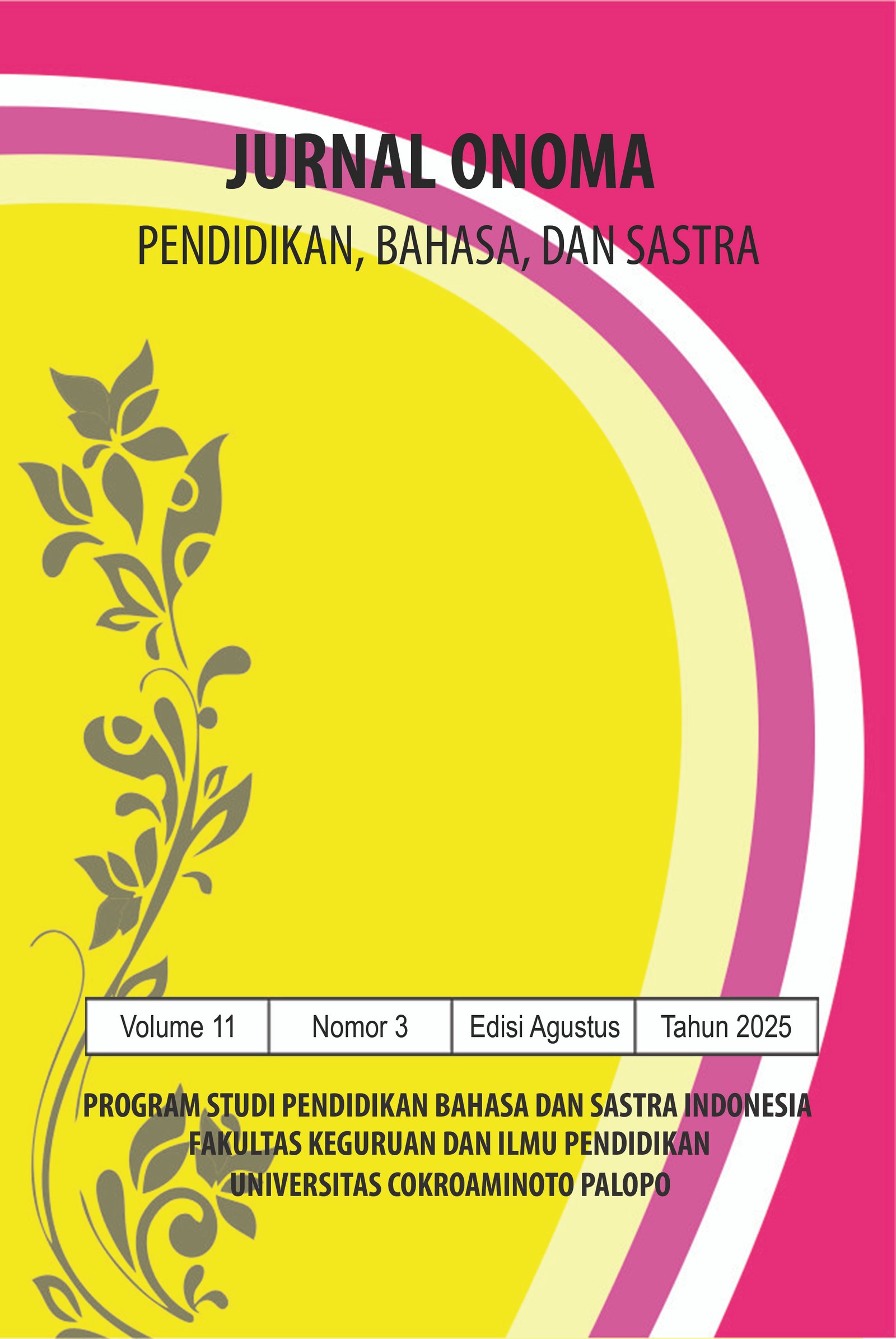An Analysis Characters and Theme of Bungo Stray Dogs: Beast By Kafka Asagiri
https://doi.org/10.30605/onoma.v11i3.6154
Keywords:
characters, characterization, theme, traumatic, Bungo Stray DogsAbstract
This study is entitled An Analysis Characters and Theme of Bungo Stray Dogs: Beast by Kafka Asagiri. Purpose of this study which to analyze the intrinsic elements such as characters and its characterization, and also the theme that formed in the story. This study was designed as qualitative research by Creswell presented in the form of dialogue and text. The data are collected by analyzing the data found in a novel entitled Bungo Stray Dogs: Beast (2019) by Kafka Asagiri. This study using descriptive qualitative methods. The theories used are Wellek & Warren's concept of character, and theory of trauma by Caruth (1996) to explain the theme. The result of the study the writers find out that the main character of the novel is Akutagawa Ryunosuke and the supporting characters are Atsushi Nakajima, Osamu Dazai, and Oda Sakunosuke and also their characterization in physiological, sociological, and psychological dimensions. The themes of this novel are friendship and Teamwork: The relationship between the main characters and the members of the Armed Detective Agency shows the importance of friendship and teamwork in facing challenge, the other themes are traumatic experience by the characters such as Akutagawa's character who lived in a cruel environment, Atsushi's character with child abuse, and Dazai's trauma of losing a friend.
Downloads
References
Ariani, N. (2010). Character and theme analysis in J.M. Coetzee novel disgrace. (Bachelor thesis, State Islamic University “Syarif Hidayatullah”, Jakarta, Indonesia). http://repository.uinjkt.ac.id/dspace/handle/123456789/835
Asagiri, K. (2019). Bungo stray dogs: Beast. Kadokawa Shoten.
Caruth, C. (1996). Unclaimed experience: Trauma, narrative, and history. The Johns Hopkins University Press.
Creswell, J. W. (1994). Research design qualitative and quantitative approaches. Sage Publication International Educational and Professional Publisher.
Freytag, G. (1900). Freytag’s Technique of the drama: An exposition of dramatic composition and art. (E. J. MacEwan, Ed.). Scott, Foresman.
Grant, M. J., & Booth, A. (2009). A typology of reviews: an analysis of 14 review types and associated methodologies. Health Information & Libraries Journal, 26(2), 91–108. https://doi.org/10.1111/j.1471-1842.2009.00848.x
Gultom, F. E. (2022). The relationship between theme and character in fiction movie inside out. BAHAS, 33(1), 3. https://doi.org/10.24114/bhs.v33i1.35546
Hasniyati, H. (2018). Eksistensi tokoh ayah dalam novel ayah karya Andrea Hirata dan novel ayahku (bukan) pembohong karya Tere Liye. Master Bahasa, 6(3), 226–238. https://doi.org/10.24173/mb.v6i3.12426
Hidayah, N. A. (2024). Depresi tokoh Dazai Osamu dalam anime bungou stray dogs karya Igarashi Takuya. (Bachelor thesis, Universitas Andalas, Padang, Indonesia). http://scholar.unand.ac.id/id/eprint/476144
Kenney, W. P. (1966). How to analyze fiction. Monarch Press.
Lathifah, N. N. (2022). Elizabeth Gilbert’s self-healing efforts from past trauma in the novel eat pray love. Lakon: Jurnal Kajian Sastra Dan Budaya, 11(2), 131–141. https://doi.org/10.20473/lakon.v11i2.36870
Liyyah, K. K. (2021). Psychological trauma of the main character in E. Lockhart’s we were liars. (Doctoral dissertation, Universitas Islam Negeri Maulana Malik Ibrahim, Malang, Indonesia). http://etheses.uin-malang.ac.id/35600/
Palmer, C., & Bolderston, A. (2006). A brief introduction to qualitative research. Canadian Journal of Medical Radiation Technology, 37(1), 16–19. https://doi.org/10.1016/S0820-5930(09)60112-2
Pebrianti, K. D. (2023). An analysis of characterization in movie moana. Journal of Language and Applied Linguistics, 4(1), 54–59. https://doi.org/10.22334/traverse.v4i1.219
Putra, I. G. A. N. A. Y. P. A., Qomariana, Y., & Soethama, P. L. (2024). Characterization of the characters in the social network movie. J-CEKI: Jurnal Cendekia Ilmiah, 3(5), 2858–2866. https://doi.org/10.56799/jceki.v3i5.4413
Saakvitne, K., Gamble, S., Pearlman, L., & Tabor, L. B. (2000). Risking connection: A training curriculum for working with survivors of childhood abuse. Sidran Press.
Wallek, R., & Warren, A. (1956). Theory of literature (3rd ed.). Harcourt, Brace & World, Inc.
Downloads
Published
How to Cite
License
In submitting the manuscript to the journal, the authors certify that:
- They are authorized by their co-authors to enter into these arrangements.
- The work described has not been formally published before, except in the form of an abstract or as part of a published lecture, review, thesis, or overlay journal.
- That it is not under consideration for publication elsewhere,
- That its publication has been approved by all the author(s) and by the responsible authorities – tacitly or explicitly – of the institutes where the work has been carried out.
- They secure the right to reproduce any material that has already been published or copyrighted elsewhere.
- They agree to the following license and copyright agreement.
License and Copyright Agreement
Authors who publish with Onoma Journal: Education, Languages??, and Literature agree to the following terms:
- Authors retain copyright and grant the journal right of first publication with the work simultaneously licensed under Creative Commons Attribution License (CC BY 4.0) that allows others to share the work with an acknowledgment of the work's authorship and initial publication in this journal.
- Authors are able to enter into separate, additional contractual arrangements for the non-exclusive distribution of the journal's published version of the work (e.g., post it to an institutional repository or publish it in a book), with an acknowledgment of its initial publication in this journal.
- Authors are permitted and encouraged to post their work online (e.g., in institutional repositories or on their website) prior to and during the submission process, as it can lead to productive exchanges, as well as earlier and greater citation of published work.

















